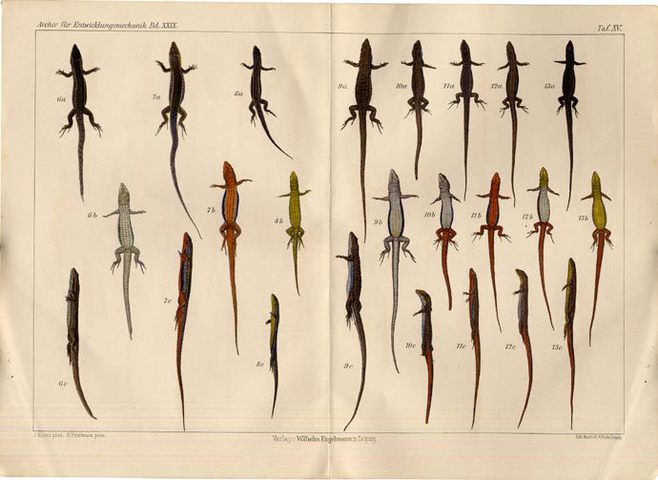KAMMERER, Paul (1880–1926)
Vererbung erzwungener Fortpflanzungsanpassungen. I-II: Die Nachkommen der spätgeborenen Salamandra maculosa und der frühgeborenen Salamandra actra (1907); Vererbung erzwungener Farbveränderungen. I-II: Induktion von weiblichen Dimorphismus bei Lacerta muralis, von männlichen Dimorphismus bei Lacerta fiumana (1910); Das Farbkleid des Feuersalamanders (Salamandra maculosa Laurenti) in seiner Abhängigkeit von der Umwelt (1913). Three offprints from Archiv für Entwicklungsmechanik der Organismen, XXV, XXIX, and XXXVI.
Leipzig, Wilhelm Engelmann, 1907, 1910 and 1913.








Three rare offprints. The Viennese biologist and socialist Paul Kammerer is one of the most ambigious, enigmatic and tragic figures in the history of biology. He believed he had proved that acquired characteristics could be genetically passed to offspring and was responsible for a series of sensational laboratory experiments which seemed to prove the Lamarckian view. Before World War I he conducted experiments with salamanders, newts and an amphibian known as the midwife toad. Salamanders raised on different coloured gravels changed their colours and breeding habits and passed the changes on to their offspring. Blind newts, bred in infra-red light, ‘redeveloped’ eyes, and male midwife toads regained the nuptial pads with which they grasp females when mating in water. After the war Kammerer travelled to England and America to continue his work, but was met with cold hostility by Mendelian geneticists. They could not reproduce his results and accused him of incompetence or fraud. In 1925 he was offered a chair at the University of Moscow. Shortly after he accepted the post, however, it was discovered that a number of his animal specimens had been deliberately faked. Kammerer denied everything, blaming one of his assistants. Few believed him. He willed his valuable library to the Univeristy of Moscow, his body to an anatomical school in Vienna, then shot himself with a revolver. Kammerer’s story was the subject of Arthur Koestler’s The Case of the Midwife Toad (1971).
Collation: 1907: pp 7-51, one plate; 1910: pp 455-98, two colour-plates (one double-page); 1913: pp 3-193, with 15 double-page plates (3 coloured).
Binding: Original printed wrappers. The collection preserved in a Solander-case decorated with reproductions of the colour-plates of salamanders.
References: Richard Milner, The Encyclopedia of Evolution (1990), pp 246-247; Martin Gardner, Fads and Fallacies in the Name of Science (1957), p. 143. In manuscript: Bengt Robertson: ‘Wienerblut. Om Paul Kammerer, Alma Mahler och den manipulerade barnmorskegrodan i Pratern’.